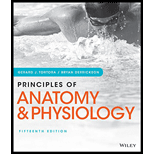
Concept explainers
List the similarities among and differences between the nervous and endocrine systems with regard to the control of homeostasis.
To review:
The similarities and differences between the nervous and endocrine systems with regard to the control of homeostasis.
Introduction
Nervous system is the network of nerves and fibers that transmit messages from the brain and spinal cord to the different body parts. Endocrine system is the group of glands that produces hormones carried by bloodstream to distant target organs for their specific functions. The nervous system and endocrine system together coordinate the functions of all body systems. There are various similarities and differences between two systems.
Explanation of Solution
Explanation
Similarities:
The nervous system acts through nerve impulses. Nerve impulses at synapse cause the release of messenger called neurotransmitter, while endocrine glands secrete hormones. Both neurotransmitters and hormones apply their effects by binding to receptors on or in their “target” cells.
Both nervous and endocrine system are essential for the control and coordination of body to maintain homeostasis.
Differences:
| Endocrine system | Nervous system | |
| Mechanism of action and molecules | Endocrine system system uses chemical messenger or hormones to send signals to the target cell through the bloodstream. | Nervous system uses neurotransmitters to send signals to the target cell through the bloodstream. |
| Action time | Responses of the endocrine system are slower usually takes minutes, hours, and even days in comparison to nervous system. | Responses of the nervous system are faster usually occur within few seconds in comparison to endocrine system. |
| Site of action | The hormones are generally targeted to distant target organs and are carried by bloodstream. | The neurotransmitters are generally targeted to short distances (synapses), which occur between two adjacent neurons. |
| Transmission of messages | The endocrine messages (hormones) are carried out chemically. | The messages (neurotransmitters) are carried out electrically. |
| Target cells | Endocrine system targets cell throughout the body. | Neurons, muscle, and gland cells. |
Conclusion
Nervous system and endocrine system are the regulatory systems that communicate between the cells, tissue, and organs. These systems control and coordinate all the body systems, thus help in maintaining the homeostasis.
Want to see more full solutions like this?
Chapter 18 Solutions
Principles of Anatomy and Physiology
Additional Science Textbook Solutions
Microbiology Fundamentals: A Clinical Approach
Chemistry: An Introduction to General, Organic, and Biological Chemistry (13th Edition)
Campbell Essential Biology (7th Edition)
HUMAN ANATOMY
Organic Chemistry
Applications and Investigations in Earth Science (9th Edition)
- ✓ Details Draw a protein that is embedded in a membrane (a transmembrane protein), label the lipid bilayer and the protein. Identify the areas of the lipid bilayer that are hydrophobic and hydrophilic. Draw a membrane with two transporters: a proton pump transporter that uses ATP to generate a proton gradient, and a second transporter that moves glucose by secondary active transport (cartoon-like is ok). It will be important to show protons moving in the correct direction, and that the transporter that is powered by secondary active transport is logically related to the proton pump.arrow_forwarddrawing chemical structure of ATP. please draw in and label whats asked. Thank you.arrow_forwardOutline the negative feedback loop that allows us to maintain a healthy water concentration in our blood. You may use diagram if you wisharrow_forward
- Give examples of fat soluble and non-fat soluble hormonesarrow_forwardJust click view full document and register so you can see the whole document. how do i access this. following from the previous question; https://www.bartleby.com/questions-and-answers/hi-hi-with-this-unit-assessment-psy4406-tp4-report-assessment-material-case-stydu-ms-alecia-moore.-o/5e09906a-5101-4297-a8f7-49449b0bb5a7. on Google this image comes up and i have signed/ payed for the service and unable to access the full document. are you able to copy and past to this response. please see the screenshot from google page. unfortunality its not allowing me attch the image can you please show me the mathmetic calculation/ workout for the reult sectionarrow_forwardIn tabular form, differentiate between reversible and irreversible cell injury.arrow_forward
- 1.)What cross will result in half homozygous dominant offspring and half heterozygous offspring? 2.) What cross will result in all heterozygous offspring?arrow_forward1.Steroids like testosterone and estrogen are nonpolar and large (~18 carbons). Steroids diffuse through membranes without transporters. Compare and contrast the remaining substances and circle the three substances that can diffuse through a membrane the fastest, without a transporter. Put a square around the other substance that can also diffuse through a membrane (1000x slower but also without a transporter). Molecule Steroid H+ CO₂ Glucose (C6H12O6) H₂O Na+ N₂ Size (Small/Big) Big Nonpolar/Polar/ Nonpolar lonizedarrow_forwardwhat are the answer from the bookarrow_forward
 Human Physiology: From Cells to Systems (MindTap ...BiologyISBN:9781285866932Author:Lauralee SherwoodPublisher:Cengage Learning
Human Physiology: From Cells to Systems (MindTap ...BiologyISBN:9781285866932Author:Lauralee SherwoodPublisher:Cengage Learning Human Biology (MindTap Course List)BiologyISBN:9781305112100Author:Cecie Starr, Beverly McMillanPublisher:Cengage Learning
Human Biology (MindTap Course List)BiologyISBN:9781305112100Author:Cecie Starr, Beverly McMillanPublisher:Cengage Learning- Lifetime Physical Fitness & WellnessHealth & NutritionISBN:9781337677509Author:HOEGERPublisher:CengageCase Studies In Health Information ManagementBiologyISBN:9781337676908Author:SCHNERINGPublisher:Cengage





